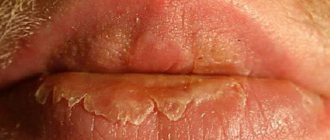Fordyce granules
Fordyce granules are hyperplastic sebaceous glands that tend to form in those areas of the body where the skin is thinnest and most delicate. Most often they are localized on the mucous membranes of the oral cavity (in particular on the cheeks), on the lips, in the groin, directly on the genitals and on the nipples. Such changes in the sebaceous glands were first described by the American dermatologist and syphilidologist John Addison Fordyce back in 1896. Hence the name that has now become generally accepted for them - Fordyce granules. Formations are considered one of the variants of the physiological norm, since they are: completely benign; do not harm health; are not accompanied by unpleasant symptoms; are not transmitted during sexual contact or any other way. That is why patients turn to specialized medical institutions only in cases where visible sebaceous glands represent a serious cosmetic defect and become a reason for a person’s dissatisfaction with their appearance. The exact reasons that provoke changes in the sebaceous glands have not been identified at the moment. However, most doctors, based on the results of pathomorphological studies of tissues, believe that the prerequisite for the occurrence of cysts are various types of congenital disorders of the development of the sebaceous glands, leading to their displacement into the upper layer of the skin or to a change in their normal location (the location of the sebaceous glands in the area of the border of the lips is considered abnormal , on the mucous membranes of the oral cavity, etc.). Another cause of Fordyce granules is considered to be hyperplasia of the excretory ducts of the sebaceous glands, which provokes the appearance of cystic formations in them. Simply put, Fordyce granules develop in people who have excessive narrowing or blockage of the excretory ducts of the glands, accompanied by the accumulation of secretions (sebum) in them. Sebaceous gland cysts first appear in humans during adolescence, when the process of puberty begins, that is, approximately in the range from 13 to 17 years. Thus, it can be assumed that the process of formation of Fordyce granules proceeds in accordance with the following algorithm: during the period of intrauterine development in the fetus, for one reason or another, the formation of the sebaceous glands is disrupted; when the child reaches a certain age, under the influence of steroid hormones that are produced by the sex glands (the so-called androgen hormones), the glands begin to increase in size and actively produce sebum, which results in their visualization.
Characteristic features of Fordyce granules. Externally, sebaceous gland cysts resemble small nodules (or papules) the size of a millet grain. As a rule, such rashes are numerous, widespread and not accompanied by pain (either at rest or when pressing on them). When pressing on the formation, in some cases a very small amount of liquid may be released from it, having a white-yellow tint and a rather thick consistency. However, more often than not, attempts to squeeze the contents out of Fordyce granules end in pinpoint bleeding and the development of hematomas in the area of skin surrounding the damaged papule.
Doctors are categorical in their prohibitions on self-removal of Fordyce granules, since this, firstly, is very painful, and secondly, provokes inflammatory processes and scarring of the skin. This is especially true in cases where the cysts are localized in the lip border area. Fordyce granules on the lips in the vast majority of cases (up to 90%) occur in women. This type of Fordyce granules occurs as a result of damage to the apocrine sweat glands, which are somewhat associated with the genitourinary system.
Treatment of Fordyce granules. Unfortunately, there are currently no effective methods for treating Fordyce granules. The use of jojoba oil and vitamin A is recommended as a means to inhibit further development of the process. These products help remove Fordyce granules that are already present and prevent the formation of new ones. Such drugs can act mainly on fresh cysts.
The main methods of removal are electrocoagulation or cryotherapy. Treatment of large Fordyce granules, as well as formations classified as old, is carried out through their surgical removal. The decision on the possible removal of certain elements is made by the attending physician. In this case, the skin over the papule is opened, the wen itself is peeled off, and the bleeding is stopped using an electrocoagulant. The edges of the operated area are sutured with special materials.
Pustovoitova E.V.
What to do if there are pimples on your lips?
Unlike other areas, white pimples on the lips are usually smaller, about 2 mm in diameter, and less prominent. In some cases, they may itch, but you should scratch them as they can become infected. You cannot squeeze them out, as this can cause microtraumas and scars.
It is necessary to consult a doctor who will make the correct diagnosis and prescribe treatment. It may turn out that the rash on the lips is a completely different disease, for example, herpes or acne.
The patient, 42 years old, was admitted to the Department of Dermatology and Venereology of the Virgen de las Nieves Hospital, Granada, Spain in May 2015 with severe pruritic rashes and hair loss in both axillary areas. Clinical examination revealed flesh-colored papules and alopecia [Fig. 1A] without glow in a Wood's lamp. Dermatoscopy revealed papules oriented in the center of the follicle, injured terminal hairs and acne elements [Fig. 1B]. Histological examination of a skin biopsy revealed a lymphocytic inflammatory infiltrate affecting the hair follicle [Fig. 1C] and obstruction of eccrine and apocrine sweat glands [Fig. 1D]. The patient was diagnosed with Fox-Fordyce disease (FF). Subsequent treatment with tretinoin (0.05%) produced moderate symptomatic improvement.
Comments
Fox-Fordyce disease is a rare chronic disease that usually occurs in adolescent girls and affects areas containing apocrine glands. The main etiological factor of Fox-Fordyce disease remains unknown, although a history of trauma due to laser hair removal and hormonal factors may act as triggers of the disease[1-4]. The pathophysiology of the disease is obstruction of the apocrine gland duct, due to the formation of a keratin plug in the wall of the hair follicle. This leads to a delay in secretion with subsequent rupture of the gland structure and the development of secondary inflammation of the dermis [2,3]. Extravasation of the contents of the gland can cause itching. Clinically, the lesions are represented by homogeneous, dense papules located around the follicle, the color of which varies from flesh-colored to brownish[3-5]. The axillae are the most common sites of involvement, as in the case presented, although Fox-Fordyce disease may also involve the anogenital and periareolar regions, lips, umbilical region, sternum, and upper medial thighs[3,4].
The diagnosis is made based on the clinical picture, as well as nonspecific histological features [1-5]. Histological features include dilatation of the follicular infundibulum with hyperkeratosis, acanthosis and spongiosis of the infundibulum epithelium and a perifollicular infiltrate of lymphocytes and foamy histiocytes, leading to hair loss[3-5]. Differential diagnosis should be made with Graham-Little-Picardie-Lassoueur syndrome and tufted hair syndrome (trichostasis spinulosa), but it should be remembered that patients with Fox-Fordyce disease do not have scarring alopecia or lesions elsewhere on the body and mucous membranes[5 ].
Many treatments have been proposed for Fox-Fordyce disease with moderate improvement, including oral contraceptives, topical, site-specific and systemic corticosteroids, topical clindamycin, pimecrolimus, phototherapy, surgical treatments including electrocoagulation and curettage with liposuction, topical or systemic retinoids, as was the case in the described clinical case[1-5].
Types of treatments
Treatment is not a necessary measure in this matter. Nevertheless, for many people it becomes relevant, as it causes many complexes about the appearance of the body.
Ointments
The most popular remedy for combating Fordyce's disease is Retin A ointment. The drug affects the secretion of the sebaceous glands and dissolves the formations that have arisen. Trans-retinoic acid, which is part of the ointment, neutralizes the contents of sebaceous plugs and regenerates skin tissue. You need to apply the cream once a day, preferably in the evening, before bed. It is important to avoid contact of the substance with the eyes and mucous membranes of the body. After 6 hours, it must be washed off with running water. The first effects are observed after 2-3 weeks. The full course of treatment lasts up to 2 months. Analogs of the cream drug Airol and Lokacid.
Removal by devices
New growths can be removed by performing an instrument procedure. Modern medicine offers many options for removing skin defects in a hospital setting:
- Cryodestruction - granules are frozen with liquid nitrogen. A special device is applied to the affected area for a few seconds. After this, the growth begins to collapse and dies.
- Laser removal is the most popular. It occurs under the influence of a special laser beam, which burns out the growth layer by layer. Removing Fordyce granules with this laser takes several minutes.
- Electrocoagulation – neutralization of the cyst occurs using high frequency electric current. The current energy accumulates in the tip, after which it evaporates the liquid from the tissues of the growth. Thanks to the method, elimination takes place without blood loss.
- The radio wave method is the most gentle. Excision is carried out by exposure to high-frequency waves that cut off the formation. Moreover, at this moment there is no contact between the device and the tissues.
We recommend reading:
- How to get rid of warts on the neck
- Is it possible to cauterize condylomas?
- Features of the appearance of a wen on the scrotum
Medications
Treatment of cysts is carried out without the use of various medications. In special cases, your doctor may recommend taking anti-inflammatory drugs or antibiotics to prevent bacterial infection. The selection of medications is solely at the discretion of the doctor, depending on the symptoms of the disease and the characteristics of the patient.
How does a cosmetologist remove it?
In addition to standard clinical treatment methods, a person with rashes can be treated at home, or seek the help of a cosmetologist.
After a diagnostic examination, the cosmetologist can select one of the most suitable methods. Most often, for such a problem, treatment with the Darsonval apparatus is used or permanent makeup is applied.
The use of Darsonval allows you to cleanse the skin, saturate it with oxygen and restore natural metabolic processes in tissues. The sebaceous department is normalized. The skin becomes more pleasant and smooth to the touch. In this case, the course of treatment will be about 10 sessions. During the procedure, the specialist installs the necessary attachment – an electrode – into the device holder. After this, light movements massage the skin. Unfortunately, cosmetologists do not give a 100% guarantee of an effective outcome. A similar procedure can also be carried out at home.
Permanent makeup is used for minor tissue damage. Especially if the growths are on the lips. To do this, a special pigment is introduced into the required area, which colors the granules that stand out in color. Tissue tattooing takes place. The result of the procedure lasts for 1-2 years, after which the event must be repeated.
Is it possible for acne to appear on the lips?
Acne is a disease of the sebaceous glands. Since there are very few of them on the red border of the lips, the likelihood of acne forming in this area is low. But acne can form in the area around the lips. If a dermatologist has diagnosed acne, he may prescribe azelaic acid preparations for treatment9. Azelik® belongs to this group of drugs. This is a 15% azelaic acid gel with the following properties5:
- the ability to normalize keratinization processes in follicles;
- anti-inflammatory effect exerted by reducing the metabolism of neutrophils and the free radical forms of oxygen they produce;
- reduction of free fatty acids in skin lipids;
- antimicrobial activity against propionibacteria and Staphylococcus epidermidis.
The results from the action of Azelik®, as a rule, become noticeable after 4 weeks of using the drug5.








